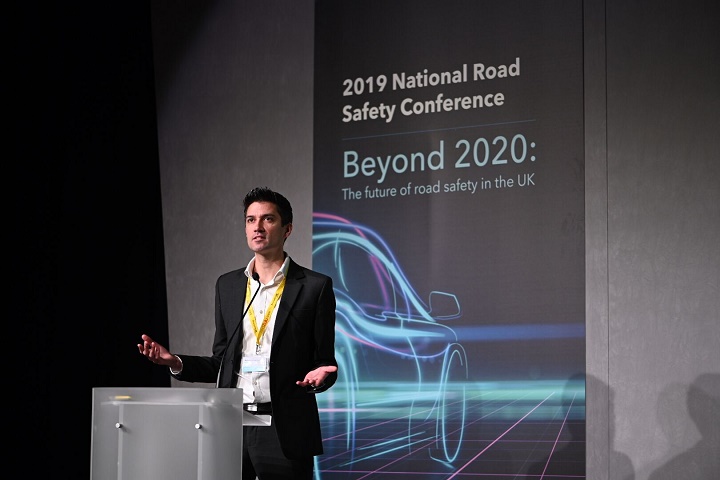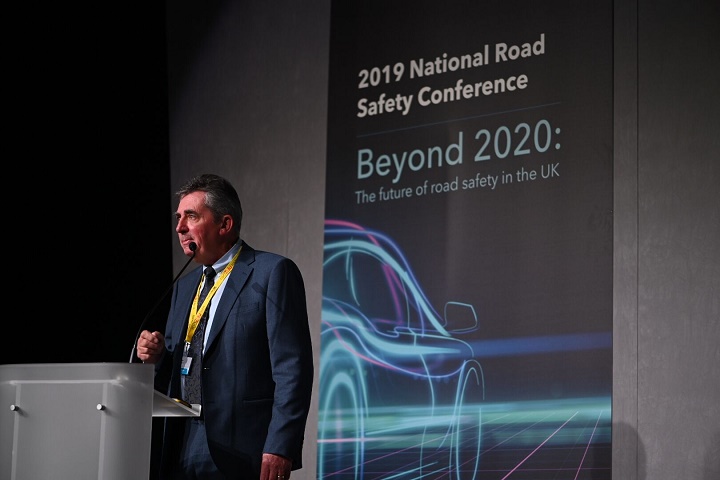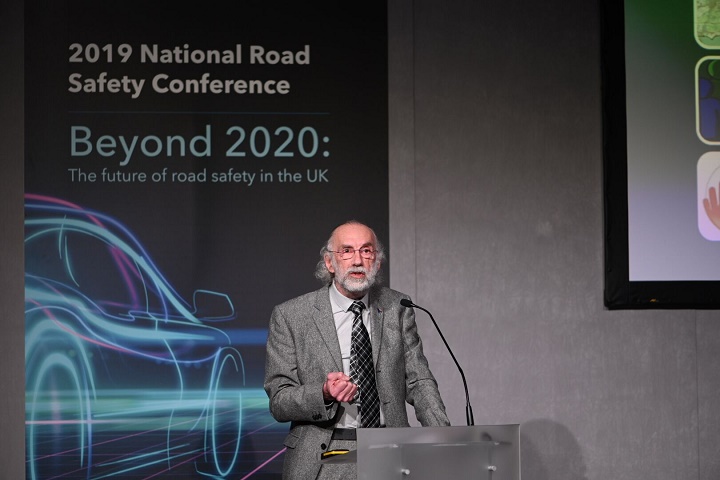
Successfully piloted in 2017 and repeated in 2018, the focus for the Hot Topic at the 2019 National Road Safety Conference will be 20mph limits/zones.
Participants:
- Richard Fernandes, senior consultant, Atkins
- Pat Bates, road safety strategy officer, Torfaen Council
- Rod King MBE, founder, 20’s Plenty for Us
This page does not automatically refresh, click here to load the latest entry.
Opening addresses
Richard Fernandes MSc CMILT, Senior Consultant, Atkins

Richard Fernandes is a transport planner with the consultancy Atkins, who has 12 years’ experience working on evaluation projects.
Richard led the analytics on the DfT’s 20mph Speed Limit Evaluation report, published in November 2018; he was responsible for both the safety and speed analysis. Both methodologies used new sources of data or new approaches to provide insight into the effectiveness of 20mph signed only interventions.
Presentation: Can 20mph limits/zones help reduce collisions and casualties, and improve road safety?
DfT funded study into 20mph signed only, aiming to:
- Strengthen the evidence base regarding the effectiveness of 20mph limits, including speed, safety, perception and attitudes
- Inform future policy development at a national and local level
Approach:
- 12 case study schemes comprising over 700kms of 20mph limits
- Locations with 30mph limits to control for background trends
Quantitative and qualitative data sources analysed:
- Over 5,400 questionnaires with residents and road users
- Over 18 million veh-kms of journey speed data
- Spot speed data for over 400 locations
- Almost 4,000 collisions in 20mph limit areas
What did we learn?
Speed profile:
- Median speed down 0.8mph and 0.6mph in residential/city centres respectively. 85th percentile speeds down more, at 1.1mph and 1.3mph respectively. These are statistically significant relative to similar 30mph comparator areas
Perception and Attitudes:
- Strong support for 20mph amongst cyclists and residents.
- Concern was about compliance.
Compliance:
- 47% of residential drivers comply and 65% of city centre.
Compliance by road type:
- Road characteristics appears to play a large role in compliance. Some roads were already experiencing lower speeds prior to introduction of 20mph.
Safety:
- No statistically significant change in collisions compared to areas which remained 30mph.
- Rate of collisions has reduced, but it has also reduced in 30mph areas.
Brighton safety:
- Brighton is the only area to show a significant reduction. This prompts further need for research into the reasons for its apparent success.
Findings
- One of the most important findings is that of compliance. Especially when we think about how to make safer roads, rather than assume roads are safer without evidence.
- One of the major conclusions from the report is that road characteristics are very important in terms of speed and compliance.
“Can 20mph limits/zones help reduce collisions and casualties, and improve road safety?”
Let’s split this into separate questions:
Q: Do lower speeds affect road safety?
A: Almost all historic research suggests lower speeds do reduce casualties
Q: Do 20mph limits/zones change driver speeds?
A: Zones (with traffic calming) do
A: Limits only have a very limited impact (<1mph)
The current application of 20mph signed only does not appear to have significant safety benefits
Some good news…
- I do feel like our research shows opportunities to improve road safety.
- The key is about learning what actually changes people’s behaviours.
- Feedback is generally positive about the concept of 20mph, but compliance is the main issue.
A question to leave you with is therefore:
How can we design the road environment to encourage lower speeds on 20/30mph roads?
Pat Bates, Road Safety Strategy Officer, Torfaen Council

Pat works as part of Torfaen Council’s highways team and is responsible for ‘front line’ work and projects as well as having a role in a strategic overview on road safety matters.
His responsibilities include road safety ETP and some road casualty reduction engineering schemes including Safe Routes to School, traffic calming, new specific 20mph speed limits and new active travel (cycling) routes.
Opening remarks
Campaigners for default signed only 20s have had a great run of campaigning for a couple of years with very little in the way of an alternative authoritative voice promoting the status quo.
We hear a lot of the proposed benefits of default signed only 20s but the challenges and downsides are less often mentioned.
It is not so much that I am against default 20s – but more that I am for the current policy centred around evidence based decision making.
Now is the time for both sides to have their say in rational discussion and work out what can actually be achieved. I believe there is a reality gap between the aspirations of campaigners and the deliverables.
I believe that the big question that pro 20s people have to address comes in two parts – firstly how can the public be won over when they know all the facts and secondly how the public can remain won over when disappointment sets in as vehicle speeds don’t change much after a large scale default 20 is introduced.
I don’t think default 20s are a good idea primarily because I am unconvinced that they can deliver what they promise. A major reason why they can’t deliver is that a very large number of drivers are not yet willing to voluntarily go slower.
To achieve compliance to 20mph speed limits we need a large scale change of driver mindset which is not yet here, coupled with either a massive level of enforcement or much more speed reducing engineering.
When the mindset has been changed it may then be time to consider changing the infrastructure and speed limits. The proposed sequence is the wrong way round at present.
I believe that bringing road safety and active travel together must be an urgent objective.
I’m not against slower speeds and have put in some 20s schemes myself – where we collectively believe they are appropriate.
And this is the key, I (and many like me) simply don’t agree with campaigners that a default 20mph in residential areas is the right way to go.
“People drive at speeds they consider to be right for the circumstances.” – Change the road environment and you can change the speeds.
Rod King MBE, Founder, 20’s Plenty for Us

Rod King started to campaign for lower speed limits in Warrington, UK in 2004. He went on to set up 20’s Plenty for Us in 2007 in order to assist others in communities which wanted lower speeds and speed limits.
With a focus on the single issue of campaigning for 20mph limits for most roads across a complete local authority, 20’s Plenty for Us now has 420 local campaigns in the UK, Ireland, USA, Canada and Australia.
Opening remarks
Does 20mph reduce speeds and kinetic energy?
There is much evidence that it does, and no evidence that it does not
A reduction in average speed from 26mph to 22mph will:
- Reduce network kinetic energy by 40%
- Reduce average stopping distance from 33m to 27m
Can 20mph reduce casualties?
Atkins good on qualitative work, but quantitative results unclear…
- Small areas of case studies (<30 casualties pa) give little confidence in significance of findings. No London boroughs and no large town on casualties
- Case studies showed big swings in ratio between crashes and casualties pointing to flawed data sets.
- Case studies of just a square km were compared to whole regions with no consideration of casualty contributors or alternative works
The link between speed and casualties is clear…
- 20mph/30kmh advised by WHO, EU, ETSC, iRAP as correct limit where vehicles mix with people.
- Global Network of Road Safety Legislators say “there is strong evidence that wherever motorized vehicles mix with vulnerable road users, the limit should be set at or under 30km/h”
- Old models of isolated and small limited areas, with little engagement or enforcement will all be bettered by wide-area, nuanced 20mph defaults
Does 20mph improve road safety and reduce danger?
- A population-wide recognition of required behavior change
- Catalyses community as part of solution to reducing road danger/increasing liveability
- Forces a consideration of speed through eyes of vulnerable road users rather than driver
- Endorses rights of walkers, cyclists, young, elderly to safely and sustainably co-exist with motor vehicles
20mph limits are not a “silver bullet”, but they can be a catalyst for changing the way we view streets, reduce speeds/casualties and make them places better suited for people rather than just motor vehicles
How can road safety partnerships maximise the benefits for all?
- Recognise the 30mph default as no longer fit for purpose
- RSPs should treat 20mph limits as an opportunity rather than a threat
- Build on the 67% supported social norm that 20 is plenty where people are
- As the need for better public health increases then RSPs are well placed to bring their skills to the movement.
- RSPs have a huge potential to build on the strong community support for 20mph limits where motor vehicles mix with pedestrians and cyclists.
- Your skills can help do it better, quicker and more successfully.
Questions from the audience
What are the public health benefits of 20mph?
PB: What actual speeds do 20mph limits produce? Signed only limits only cause a slight reduction in speed – how much of an impact will that have on collisions and pollution?
RK: Challenging the dominance of the car – encouraging more people to walk/cycle.
RF: If speeds are lower, people will be safer and places will become more livable. Residents with 20mph feel there area is a better place to live.
Will people tolerate non compliance?
RF: People overwhelmingly in support of 20mph in there areas – even if compliance isn’t as strong as they would like. They wouldn’t want to see their 20mph limit removed.
PB: Most people want to know how we are going to get speeds down. ‘What’s the point of having it?’ if drivers don’t comply.
Polarised opinions among people of 30mph limits in their area.
Addressing the most severe speeders is key.
RK: When a community says cars are driving too fast, they use 30mph as a reference point.
Time to change the reference point – 20mph where people are.
“People drive at speeds they consider to be right for the circumstances”
Unfortunately, that doesn’t explain the variation in speeds for the same circumstances. The average speed (give or take 10%) is a good reflection on appropriate speed for circumstances and yet there will always be speeds above that..presumably misjudged by the drivers to be ‘right’ for the circumstances – assuming they gave it any thought at all.
Hugh Jones
--3